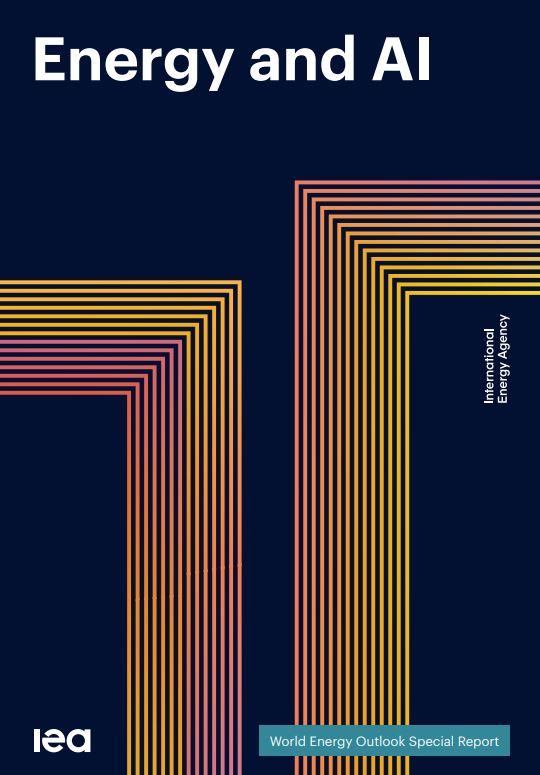
- 특히 AI 전용 데이터센터의 전력수요는 4배 이상 증가할 것으로 예상됨
□ 보고서는 2030년까지 미국에서 AI를 포함한 전체 데이터센터에 사용되는 전력은 철강과 시멘트, 화학 등 에너지 집약적 산업에서 사용되는 전력을 모두 합친 규모를 추월할 것이라고 전망함
- 현재 가동되는 데이터센터는 약 10만 가구가 사용하는 전력을 소모함
□ 이로 인해 AI 기술 경쟁이 기후위기 대응에 부정적인 영향을 줄 것이라는 우려도 제기되나, 보고서는 AI를 활용해 에너지 사용을 효율화할 경우 전체적으로 온실가스 배출을 줄일 수 있다고 지적함
- AI로 전력망 설계를 개선할 수 있을 뿐 아니라 자율주행이나 대중교통 최적화 등을 통해 에너지의 효율적인 사용을 촉진할 수 있다는 것임
[출처] AI 데이터센터 에너지 사용량 폭증…“2030년엔 현재의 4배” (2025.04.10.) / 연합뉴스
목차
Foreword 3
Acknowledgements 5
Executive summary 13
1. The rise of AI and its nexus with energy 19
1.1 Introduction 20
1.2 The rise of AI 21
1.2.1 Surging expectations in financial markets 22
1.2.2 How do households and business use AI? 24
1.3 What is AI? 28
1.3.1 Types of AI 29
1.3.2 The AI supply chain 30
1.3.3 Types of AI infrastructure 32
1.3.4 How capable is AI and can we measure it? 34
1.4 Energy for AI for energy 37
1.4.1 AI model life cycle and energy consumption 39
2. Energy for AI 49
2.1 Introduction 50
2.1.1 Case design 50
2.1.2 Key definitions and concepts 51
2.2 Electricity consumption of data centres 54
2.2.1 Historical electricity consumption of data centres 54
2.3 Outlook for electricity consumption from data centres 62
2.3.1 Outlook in the base case 62
2.3.2 Outlook in the sensitivity cases 66
2.4 Implications of AI for ICT sector energy use 71
2.4.1 Drivers and outlook for edge applications of AI 72
2.5 Electiricity supply to meet data centre demand 75
2.5.1 Procurement strategies of technology companies 75
2.5.2 Matching electricity supply with data centre demand 79
2.5.3 Electricity supply in the base case 86
2.5.4 Electricity supply in the sensitivity cases 91
2.6 Data centre interactions with the electricity grid 93
2.6.1 Is there a risk of delays in connecting data centres to the grid? 93
2.6.2 Data centre locational flexibility 96
2.6.3 Data centre operational flexibility 100
2.6.4 Optimising interactions with power system operators and planners 105
3. AI for energy optimisation 109
3.1 Introduction 110
3.2 The role of AI in the energy system 112
3.3 AI for energy and minerals supply 114
3.3.1 AI for oil and gas supply 115
3.3.2 AI for critical minerals supply 120
3.4 AI for the electricity sector 122
3.4.1 AI applications for power system operations 122
3.4.2 AI applications for power plants and storage 124
3.4.3 AI for electricity networks 129
3.5 AI for energy and uses 134
3.5.1 AI for industry 134
3.5.2 AI for transport 143
3.5.3 AI for buildings 150
3.6 AI for energy system resilience 159
3.7 Barriers to the adoption of AI for energy optimisation 162
4. AI for energy innovation 165
4.1 Introduction 166
4.2 What can we learn from patents and start-ups? 168
4.3 How can AI accelerate solutions to energy innovation challenges? 172
4.3.1 Overview of the innovation cycle 172
4.3.2 Integrating AI into the innovation process 173
4.3.3 What energy technology areas will be accelerated by AI? 175
4.4 Focus on four selected technology areas 177
4.4.1 Batteries 177
4.4.2 Catalysts for synthetic fuel production 181
4.4.3 CO2 capture materials 185
4.4.4 Cement production 190
4.4.5 Summary 194
4.5 Policies to accelerate AI innovation 198
4.5.1 Innovation funding 198
4.5.2 Data, models and computing infrastructure 200
4.5.3 Conclusions and future directions 203
5. Emerging themes on energy and AI 205
5.1 Introduction 206
5.2 Energy security in the age of AI 207
5.2.1 Applications of AI that enhance energy security 207
5.2.2 The security of energy sector supply chains for AI 209
5.2.3 Smart integration of data centres to mitigate risks 215
5.3 Enhancing the dialogue between the technology sector and the energy
industry 217
5.3.1 Better understanding the outlook for demand 217
5.3.2 Leveraging the innovation potential of the digital sector 219
5.4 Implications for investment 222
5.4.1 Data centre investment 222
5.4.2 Potential for data centres to support electricity investment 226
5.5 Are digital skills in the energy sector a bottleneck? 229
5.5.1 Demand for AI and digital skills in the energy sector 229
5.5.2 Barriers to developing AI literacy in energy firms 231
5.6 Bridging the digital divide: The energy-AI nexus in emerging market and
developing economies 233
5.6.1 Power reliability as a barrier in emerging market and developing
economies 234
5.6.2 The role of AI applications in the energy sector in emerging
market and developing economies 235
5.6.3 Overcoming diverse barriers and laying the policy groundwork
for inclusive AI in energy 237
5.7 The AI and energy policy landscape 238
5.7.1 The enabling role of government in AI development 238
5.7.2 Energy and AI policy frameworks 240
5.8 An exploratory approach to determine the potential impact of AI on
emissions 244
5.8.1 Contextualising emissions growth from data centres 246
5.8.2 The role of AI in reducing emissions from energy use 249
5.8.3 The uncertain impacts of rebound effects from AI 251
Annexes
Annex A. Methodology and data tables 255
Annex B. Definitions 261
Annex C. References 275


